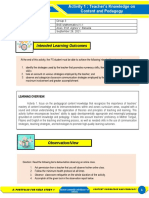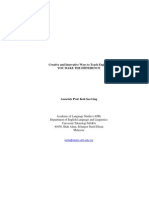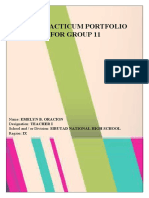0 ratings0% found this document useful (0 votes)
38 viewsBandura's
Bandura's
Uploaded by
InChrist Harieboy LaganThe document discusses three concepts for teaching: motivation, attention, and observation. For motivation, teachers should be role models and encourage students to set reasonable goals. For attention, teachers should vary their voice and write pop quiz questions on the board. For observation, teachers should assess students through tests, research, and interviews to understand students' questions.
The document also discusses laws of readiness, effect, and exercise. For readiness, teachers should motivate students before a course by showing previews and explaining importance and expectations. For effect, students are more likely to study if they get good grades. For exercise, frequent linking of stimuli and responses makes responses more likely, so practice leads to perfection.
Copyright:
© All Rights Reserved
Available Formats
Download as DOCX, PDF, TXT or read online from Scribd
Bandura's
Bandura's
Uploaded by
InChrist Harieboy Lagan0 ratings0% found this document useful (0 votes)
38 views2 pagesThe document discusses three concepts for teaching: motivation, attention, and observation. For motivation, teachers should be role models and encourage students to set reasonable goals. For attention, teachers should vary their voice and write pop quiz questions on the board. For observation, teachers should assess students through tests, research, and interviews to understand students' questions.
The document also discusses laws of readiness, effect, and exercise. For readiness, teachers should motivate students before a course by showing previews and explaining importance and expectations. For effect, students are more likely to study if they get good grades. For exercise, frequent linking of stimuli and responses makes responses more likely, so practice leads to perfection.
Copyright
© © All Rights Reserved
Available Formats
DOCX, PDF, TXT or read online from Scribd
Share this document
Did you find this document useful?
Is this content inappropriate?
The document discusses three concepts for teaching: motivation, attention, and observation. For motivation, teachers should be role models and encourage students to set reasonable goals. For attention, teachers should vary their voice and write pop quiz questions on the board. For observation, teachers should assess students through tests, research, and interviews to understand students' questions.
The document also discusses laws of readiness, effect, and exercise. For readiness, teachers should motivate students before a course by showing previews and explaining importance and expectations. For effect, students are more likely to study if they get good grades. For exercise, frequent linking of stimuli and responses makes responses more likely, so practice leads to perfection.
Copyright:
© All Rights Reserved
Available Formats
Download as DOCX, PDF, TXT or read online from Scribd
Download as docx, pdf, or txt
0 ratings0% found this document useful (0 votes)
38 views2 pagesBandura's
Bandura's
Uploaded by
InChrist Harieboy LaganThe document discusses three concepts for teaching: motivation, attention, and observation. For motivation, teachers should be role models and encourage students to set reasonable goals. For attention, teachers should vary their voice and write pop quiz questions on the board. For observation, teachers should assess students through tests, research, and interviews to understand students' questions.
The document also discusses laws of readiness, effect, and exercise. For readiness, teachers should motivate students before a course by showing previews and explaining importance and expectations. For effect, students are more likely to study if they get good grades. For exercise, frequent linking of stimuli and responses makes responses more likely, so practice leads to perfection.
Copyright:
© All Rights Reserved
Available Formats
Download as DOCX, PDF, TXT or read online from Scribd
Download as docx, pdf, or txt
You are on page 1of 2
3 Concepts How to apply it in my teaching
1 Motivation 1.1 Being a teacher, you need to become a
role model for student’s interest.
1.2 And In teaching you should set realistic
performance goals and encourage students to
set their own reasonable goals so that they can
be achieved.
2 Attention 2.1 You need to change voice volume and
tone In many cases, let students know that it's
time to pay attention.
2.2 You need to write pop quiz questions on
the blackboard Write basic reading questions
on the blackboard. Students must answer and
submit the paper. In this way, students can
quickly focus on the subject. Questions can
lead to discussions after the quiz.
3 Observation 3.1 During your discussion you must have
student assessment like Testing, research, and
ongoing assessments can provide valuable
data for action research. Your course requires
you to set up a student evaluation method and
evaluate the student for use in your project.
3.2 Lastly during you discussion also you
need to Interview your students to give them
more opportunities to express their questions
and concerns, but they can be time consuming
and difficult to collect and interpret.
Law of Readiness How I would apply the primary Law
It is your job as an educational designer to
create this e-learning course that encourages
learning. This can be done in the following
ways:
1. Start the learner before starting the
course. This can be done through a
short video showing the activity or
content before work. Creating
expectations can increase and
motivate learners before they access
the content.
2. Inform students why it is important to
study the subject and what to expect
from the course. By sharing what they
are trying to learn, you are motivating
learners to meet already established
standards. Understand how your
content is organized and determine the
expected results.
Law of effect If you study and get good grades on one
exam, you are more likely to study for the
next exam. The harder you work and get
promotions and salary increases, the more
likely you are to stay focused on your work.
Law of Exercise In learning, the more often stimuli and
responses are linked, the more likely each
response is to follow the stimulus. The law
implies that one cannot learn by doing, for
example, by observing others. Perfection of
practice is an example of the law of practice.
You might also like
- Practical Research 2: Quarter 2 - Module 1: Quantitative Research Design and Sampling ProceduresDocument32 pagesPractical Research 2: Quarter 2 - Module 1: Quantitative Research Design and Sampling ProceduresLysss Epssss81% (27)
- Practical Research 1 Module 3 - REVISEDDocument22 pagesPractical Research 1 Module 3 - REVISEDALEX PANERIO90% (10)
- 3IS-Inquiries, Investigations and Immersions - Q1 - SHS AppliedDocument47 pages3IS-Inquiries, Investigations and Immersions - Q1 - SHS AppliedElenear De Ocampo78% (32)
- MELCs of 21st Century Literature From The Philippines and The World For G11Document4 pagesMELCs of 21st Century Literature From The Philippines and The World For G11Jamaica Castillo80% (5)
- History Lesson PlanDocument3 pagesHistory Lesson Plansiphiwo dlaminiNo ratings yet
- Wonders Lesson Plan Haiku Seans 3 30 15Document5 pagesWonders Lesson Plan Haiku Seans 3 30 15api-318395482No ratings yet
- InterviewDocument5 pagesInterviewZaenul WafaNo ratings yet
- Fs1 Episode 10Document4 pagesFs1 Episode 10piadozo.paulinejoybeedNo ratings yet
- Answer in FLCTDocument4 pagesAnswer in FLCTJerra Calixterio CagsawaNo ratings yet
- Eng 211 ActivitiesDocument12 pagesEng 211 Activitiesjuvy ann bagatilaNo ratings yet
- Lesson 2: Designing Lessons and Assessments in The Different LdmsDocument5 pagesLesson 2: Designing Lessons and Assessments in The Different LdmsFatima UliNo ratings yet
- Ran FS1 Ep9Document14 pagesRan FS1 Ep9mary grace manalangNo ratings yet
- Output PhiolosophicalDocument5 pagesOutput PhiolosophicalNENA ABASOLONo ratings yet
- LAS 10 The Instructional CycleDocument5 pagesLAS 10 The Instructional CycleHiezel G LandichoNo ratings yet
- DLL-Week-1 HGDocument5 pagesDLL-Week-1 HGTRICIA DIZONNo ratings yet
- Assessment Module 1 - SamDocument7 pagesAssessment Module 1 - SamJazel CuyosNo ratings yet
- 6 InitialactivityDocument5 pages6 InitialactivityLaura Leto MilicevicNo ratings yet
- English For Academic and Professional Purposes: Quarter 2 - Module 2: Writes Various Kinds of Position PapersDocument21 pagesEnglish For Academic and Professional Purposes: Quarter 2 - Module 2: Writes Various Kinds of Position PapersRainee Anne DeveraNo ratings yet
- SupplementaryC SCOPEANDDELIMITATIONOFRESEARCHDocument14 pagesSupplementaryC SCOPEANDDELIMITATIONOFRESEARCHVince Joshua AbinalNo ratings yet
- FS2 Episode 10Document6 pagesFS2 Episode 10Larisa Mae Rosales88% (8)
- Purcomm ModDocument55 pagesPurcomm ModCECILIA ANDAYANo ratings yet
- Diding (Socstud L19-20)Document8 pagesDiding (Socstud L19-20)Debelyn CascayoNo ratings yet
- Modules FinalDocument68 pagesModules FinalFrancis JavonilloNo ratings yet
- Junio Bryan F. FS2 Activity 3 G4Document7 pagesJunio Bryan F. FS2 Activity 3 G4Bryan JunioNo ratings yet
- ED 106 Module (3rd-4th Week)Document6 pagesED 106 Module (3rd-4th Week)Mariza GiraoNo ratings yet
- AssessmentDocument28 pagesAssessmentluper4609No ratings yet
- EP 13 UpdatedDocument4 pagesEP 13 UpdatedBae Kellah Kassandra LandaweNo ratings yet
- FS Episode 10 PDF Learning TeachersDocument1 pageFS Episode 10 PDF Learning Teachersjudepingol06No ratings yet
- FS2 - Learning Episode 7 Guiding Principles in The Selection and Use of Teaching MethodsDocument10 pagesFS2 - Learning Episode 7 Guiding Principles in The Selection and Use of Teaching Methodssheilajanedlasala100% (1)
- OBSERVATION SHEET 2 FinalDocument17 pagesOBSERVATION SHEET 2 Finalscarletash169No ratings yet
- Gen Physics 2Document21 pagesGen Physics 2Josephine QuiaoNo ratings yet
- Activity 1 FS 1Document8 pagesActivity 1 FS 121bgu0195msNo ratings yet
- Pre Observation Conference Tool CabanagDocument1 pagePre Observation Conference Tool Cabanagakosijoven1234No ratings yet
- Name: Student Number: Unit: Assessment: Date of SubmissionDocument24 pagesName: Student Number: Unit: Assessment: Date of Submissionssharsha.shiniNo ratings yet
- Unit-2 Study Skills, How To Study BetterDocument17 pagesUnit-2 Study Skills, How To Study BetterjadeNo ratings yet
- ED105 ReviewerDocument10 pagesED105 Revieweraizabhelle2003No ratings yet
- Portfolio Field StudyDocument80 pagesPortfolio Field StudyBenjo Tanguan BaquirinNo ratings yet
- FIELD STUDY 4 (Interview)Document8 pagesFIELD STUDY 4 (Interview)Julius BaldivinoNo ratings yet
- Obe LP Final NaniDocument17 pagesObe LP Final NaniKert IbañezNo ratings yet
- Personal Learnign ToolDocument18 pagesPersonal Learnign Toolapi-703821832No ratings yet
- Practical Research 1: Quarter 4 - Module 24.2 Data Collection Through An InterviewDocument14 pagesPractical Research 1: Quarter 4 - Module 24.2 Data Collection Through An Interview김티카No ratings yet
- Study Notebook Module 1 OutputDocument12 pagesStudy Notebook Module 1 OutputDONALYN VERGARANo ratings yet
- FS 1 Le10Document3 pagesFS 1 Le10Jorebell W. QuiminoNo ratings yet
- Lesson Plan With AnnotationsDocument8 pagesLesson Plan With AnnotationsMarivic PuddunanNo ratings yet
- Professional Development Plan 1Document29 pagesProfessional Development Plan 1Hessa MohammedNo ratings yet
- Module 1 Related Activities Lesson 1: Course OverviewDocument5 pagesModule 1 Related Activities Lesson 1: Course OverviewClaudine MarmolNo ratings yet
- HG-G9 Module 2 RTPDocument14 pagesHG-G9 Module 2 RTPNiña Creoni Naja-Una PadiosNo ratings yet
- Senior Practical Research 2 Q1 Module1Document24 pagesSenior Practical Research 2 Q1 Module1spenyebey83% (12)
- Project & Problem LearningDocument10 pagesProject & Problem LearningHiba AmmarNo ratings yet
- Celis FS1-WS7Document4 pagesCelis FS1-WS7PAULA DANIELLE CELISNo ratings yet
- Enero - Chrisna Ian Lou M.-Bsed-Eng-3b-Ped-7-Module-1-Lesson-1Document6 pagesEnero - Chrisna Ian Lou M.-Bsed-Eng-3b-Ped-7-Module-1-Lesson-1Chrisna Ian Lou EneroNo ratings yet
- Observation-Sheet-1 JIMDocument4 pagesObservation-Sheet-1 JIMJim Russel SangilNo ratings yet
- Senior Practical-Research-2-Q1-Module7 For PrintingDocument20 pagesSenior Practical-Research-2-Q1-Module7 For PrintingEustass Kidd100% (1)
- FS1 Ep10Document8 pagesFS1 Ep10Millet CastilloNo ratings yet
- PerDev Q2 Mod6 Planning How To Make Family Firmer and Gentler With Each Other v5Document20 pagesPerDev Q2 Mod6 Planning How To Make Family Firmer and Gentler With Each Other v5Yanyan Palcis MicutuanNo ratings yet
- TMN3703 ExamDocument11 pagesTMN3703 ExamLindokuhleNo ratings yet
- FS1 Activity 1 Group3Document8 pagesFS1 Activity 1 Group3Honey Fujisawa60% (5)
- DocumentDocument6 pagesDocumentAmna KhalilNo ratings yet
- The Physics Lesson: Teacher Revena's ClassDocument17 pagesThe Physics Lesson: Teacher Revena's Classdpj25qmjwbNo ratings yet
- FS1. Ep9 Ep16Document52 pagesFS1. Ep9 Ep16Marites Deliarte DipadNo ratings yet
- Efficient Learning: The Relaxed Guide to Exam Success for StudentsFrom EverandEfficient Learning: The Relaxed Guide to Exam Success for StudentsNo ratings yet
- The Effects of Social Media On The StudyDocument22 pagesThe Effects of Social Media On The StudyInChrist Harieboy LaganNo ratings yet
- Art Analysis WorksheetDocument2 pagesArt Analysis WorksheetInChrist Harieboy LaganNo ratings yet
- A Semi-Detailed Lesson Plan in English 3 I. ObjectivesDocument3 pagesA Semi-Detailed Lesson Plan in English 3 I. ObjectivesInChrist Harieboy LaganNo ratings yet
- Bribery and Corruption at Siemens Case StudyDocument2 pagesBribery and Corruption at Siemens Case StudyInChrist Harieboy Lagan100% (1)
- Collaborate With Your Group and Perform The FollowingDocument3 pagesCollaborate With Your Group and Perform The FollowingInChrist Harieboy LaganNo ratings yet
- Compare and Contrast ASEAN From Other Regional Organizations Such As The European UnionDocument1 pageCompare and Contrast ASEAN From Other Regional Organizations Such As The European UnionInChrist Harieboy LaganNo ratings yet
- Ang Sining Ba Ay Isang Imitasyon o PaglikhaDocument1 pageAng Sining Ba Ay Isang Imitasyon o PaglikhaInChrist Harieboy LaganNo ratings yet
- You Believe That Every Learners Have Different Level of Thinking Skills To Cope Up With The LessonDocument1 pageYou Believe That Every Learners Have Different Level of Thinking Skills To Cope Up With The LessonInChrist Harieboy LaganNo ratings yet
- Grade 4 DLP 1st Quarter EnglishDocument82 pagesGrade 4 DLP 1st Quarter EnglishInChrist Harieboy Lagan100% (2)
- I. Learning Objectives: Grade 5 MathematicsDocument5 pagesI. Learning Objectives: Grade 5 MathematicsJes SaNo ratings yet
- Teaching Goal Examples: Retrieved From Http://sitemaker - Umich.edu/ginapchaney/teaching - Goals - PhilosophyDocument1 pageTeaching Goal Examples: Retrieved From Http://sitemaker - Umich.edu/ginapchaney/teaching - Goals - PhilosophyFang GohNo ratings yet
- Developing Learning Materials For Specific Purposes: Y. M. HarsonoDocument11 pagesDeveloping Learning Materials For Specific Purposes: Y. M. HarsonoclarisseNo ratings yet
- Datamex College of Saint Adeline Datamex Institute of Computer TechnologyDocument3 pagesDatamex College of Saint Adeline Datamex Institute of Computer TechnologyAngelica mae FedelinNo ratings yet
- DLL - PS Feb. 3 - 4Document3 pagesDLL - PS Feb. 3 - 4Hyacinth Rae Ramirez Aranas - LipatNo ratings yet
- Cooperative Learning Structures Can Increase Student AchievementDocument13 pagesCooperative Learning Structures Can Increase Student AchievementNorfarehanfadzin SugarcandyNo ratings yet
- Word Formation Processes LPDocument2 pagesWord Formation Processes LPAmy A. Ognayon100% (3)
- ParametersDocument2 pagesParametersDarlene Dacanay DavidNo ratings yet
- Progressive EducationDocument7 pagesProgressive EducationSharia Hanapia PasterNo ratings yet
- DLL - Araling Panlipunan-9 (June 10-13)Document3 pagesDLL - Araling Panlipunan-9 (June 10-13)G-one Paisones100% (1)
- Curriculum Evaluation SlideDocument11 pagesCurriculum Evaluation SlideKomathi ArumugamNo ratings yet
- Didactic Planning and The Teaching of English AsDocument13 pagesDidactic Planning and The Teaching of English AsLaaChiikiNo ratings yet
- COT T1 3 - InterRater PDFDocument1 pageCOT T1 3 - InterRater PDFOdie PenafloridaNo ratings yet
- Gettysburg Lesson PlanDocument3 pagesGettysburg Lesson Planapi-402483484No ratings yet
- Besgen Final Unit Lesson Plan Ted 635Document11 pagesBesgen Final Unit Lesson Plan Ted 635api-231778971No ratings yet
- TKT Unit 20Document28 pagesTKT Unit 20eder zapataNo ratings yet
- Lesson Plan in English - FOR ENG. 4Document3 pagesLesson Plan in English - FOR ENG. 4Lady Lou Ignacio LepasanaNo ratings yet
- Collaborative LearningDocument7 pagesCollaborative Learningdisran_spd100% (1)
- Creative and Innovative Ways To Teach English: You Make The DifferenceDocument7 pagesCreative and Innovative Ways To Teach English: You Make The DifferencewoanzhoshiaNo ratings yet
- Southwood School - Training and Development - PPT - FINAL2Document23 pagesSouthwood School - Training and Development - PPT - FINAL2Jody Gonzales100% (1)
- Mtts Parent Night PowerpointDocument17 pagesMtts Parent Night Powerpointapi-333304358No ratings yet
- DO5s2024 Orientation Material 2Document106 pagesDO5s2024 Orientation Material 2michaelvincent.monteroNo ratings yet
- LDM Practicum Portfolio For Group 11Document22 pagesLDM Practicum Portfolio For Group 11Jessie MamitesNo ratings yet
- Academic Performance Satisfaction of Grade 11 StudentsDocument6 pagesAcademic Performance Satisfaction of Grade 11 StudentsMylee LopezNo ratings yet
- RPMS With Movs and Annotations JINKY MACALAGUING (Autosaved)Document104 pagesRPMS With Movs and Annotations JINKY MACALAGUING (Autosaved)Joey Orale100% (1)
- Siop Lesson PlanDocument3 pagesSiop Lesson Planapi-371649683No ratings yet


































































































